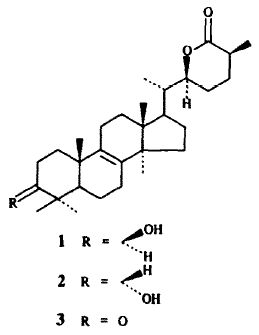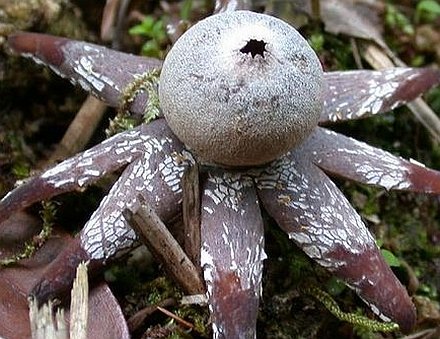The barometer earthstar, Astraeus hygometricus (Pers.) Morgan.
Classification
Kingdom Fungi
Phylum Basidiomycota
Class Basidiomycetes
Order Boletales
Family Astraeaceae
Genus Astraeus
Synonyms
Astraeus stellatus (Scop.) E. Fisch.
Nat. Pflanzenfam. (Leipzig) 1(1): 341 (1900)
Geastrum hygrometricum Pers. [as ‘Geaster‘]
Syn. meth. fung. (Göttingen) 1: 135 (1801)
Geastrum hygrometricum ß anglicum Pers.
Syn. meth. fung. (Göttingen) 1: 135 (1801)
Geastrum stellatus (Scop.) Wettst. [as ‘Geaster‘]
Geastrum vulgaris Corda [as ‘Geaster‘]
Icon. fung. (Prague) 5: 64 (1842)
Lycoperdon stellatus Scop.
Fl. carniol., Edn 2 (Wien) (1772)
Common names
Barometer Earthstar
Hygroscopic Earthstar
Water measurer
This species is easily recognizable because the exoperidium splits radially into rays to form a star-like pattern at maturity. The rays wrap around the spore puffball until rain or high humidity causes them to swell and fold downward, lifting the puffball off the ground and facilitating spore dispersal via air currents. The rays shrivel and fold up when the air dries out. It has been reported that Astraeus forms ectomycorrhizal associations with several host tree species including Pseudotsuga, Alnus, Eucalyptus and Castanea. Chakraborty et al. (2004) report that it grows in association with the roots of Chir pine (Pinus roxburghii) and sal (Shorea robusta) trees.

My name is Austin Collins.
I've dedicated my life to Mushrooms.
I believe Mushrooms are the best kept secret when it comes to health and well being.
For that reason, I would like to share a company with you that in my opinion makes the best mushroom products on the market.
The company is called Noomadic Herbals, my favorite supplement they make is called "Mushroom Total".
I take their products every day and they have helped me think better and have more energy. Give them a try.
-Austin
Description
Basidiomes: globose or depressed globose, subepigeous, sessile 18.7-29.7 mm in diameter, splitting to become star-shaped, covered with thin, white mycelial layer when unexpanded which tears away at maturity, often partly encrusted with soil debris; with slight odor when fresh.
Outer peridium: whitish, thick, composed of several layers ( ≥1 mm when dry), rigid, surface granulose, at maturity splitting into 5-12 acute rays which expand or recurve when moist and roll inwards again on drying; inner layer whitish becoming smoke-grey, cigar-brown or sepia, thick, extensively longitudinally cracked in mature specimens.
Endoperidum: sessile, subglobose, 13-24 mm in diameter, whitish to smoke-grey, opening by an apical, irregular mouth lacking defined peristome.
Gleba: pure white in early stages, purplish chestnut when mature, columella none; capillitium of long, branched, interwoven, hyaline, slightly encrusted, aseptate threads, 2.5-7.5 µm in diameter; wall thin or thickened with a narrow, sometimes discontinuous lumen; clamp-connections present.
Basidiospores: globose, ranging from 8.75-15.2 µm diameter including ornamentation, purplish chestnut, very densely ornamented with rounded, narrow, tapered, occasionally coalescent, spines 0.90-1.45 µm long.
Habitat: sandy or lateritic soil in dry lowland dipterocarp forests, fruiting frequently in rainy season between May-August.
Distribution: Worldwide, usually occurring in sandy soil in coniferous or mixed woods. Has been previously reported from North America, Argentina and Mexico, Europe, Australia.
(Description adapted from Phosri et al., 2004).
Bioactive compounds
Polysaccharides isolated from the hot aqueous extract of Astraeus hygrometricus contained D-galactose, D-glucose and D-galacturonic acid in a 1.9:0.9:1.0 mole ratio. The linkages among the constituent sugar residues were identified as, D-Gal(p) (1,6)-linked, D-Gal(p) (1,2,6)-linked, D-Glc(p) (1,3)-linked and D-Gal(p). UA is glycosidically linked. The anomeric configurations of the constituent sugar residues were and it was found that galactose and galacturonic acid have β-configuration and glucose has α-configuration. The structure of the repeating unit of the polysaccharide was determined to be (1→6)-β-D-Galp-(1→6)-β-D-Galp-(1→3)-α-D-Glcp-1- (2→1)-β-D-GalpUA (Pramanik and Islam, 2000).
A water-soluble fraction was isolated from the aqueous extract of the fruit bodies of Astraeus hygrometricus; fractionation of this extract by gel permeation chromatography resulted in two homogenous fractions. On the basis of total hydrolysis, methylation analysis, periodate oxidation, and Nuclear Magnetic Resonance (NMR) studies, the structure of the repeating unit of the glucan from fraction I (named ASQ-I) was determined to be
This glucan combines the (1→6)-β-D-glucan and the (1→4)-β-D-glucan elements that are known to be effective antitumor agents in other fungi. Therefore, it is not surprising that the earthstar glucan was shown to stimulate splenocytes in a dose-dependent fashion (Chakraborty et al., 2004).
The second polysaccharide fraction (AQS-II) was chemically characterized a few years later by the same group. This fraction was found to contain 63% polysaccharide and 35% protein. The polysaccharide part contains glucose, galactose, and fucose in a 2:1:1 molar ratio. Using techniques such as total acid hydrolysis, methylation analysis, periodate oxidation, and NMR studies, the chemical structure of the repeating unit of the polysaccharide was determined, and is shown below (Chakraborty et al., 2007)

Three triterpenes have been isolated from the fruiting bodies. These compounds are 3-hydroxy-lanostane derivative with a D-lactone in the side chain. The structures (shown below) were named (1) astrahygrol, (2) 3-epi-astrahygrol, and (3) astrahygrone (Takaishi et al., 1987). This same paper also reported the isolation of the known steroids ergosta-7,22-diene-3-ol acetate and ergosta-4,6,8-(14),22-tetraene-3-one.

Links
- Tom’s Fungi features the Earthstar in a ‘Fungus of the Month’ feature.
References
Chakraborty I, Mondal S, Pramanik M, Rout D, Islam SS.
Structural investigation of a water-soluble glucan from an edible mushroom, Astraeus hygrometricus.
Carbohydr Res. 2004 339(13):2249-54.
Chakraborty I, Mondal S, Rout D, Chandra K, Islam SS.
Structural investigation of a heteroglycan isolated from the fruit bodies of an ectomycorrhizal fungus Astraeus hygrometricus.
Carbohydr Res. 2007 342(7):982-7.
Phosri C, Watling R, Martin MP, Whalley AJS.
The genus Astraeus in Thailand.
Mycotaxon. 2004 89(2):453-63.
Pramanik A, Islam SS.
Structural studies of a polysaccharide isolated from an edible mushroom, Astraeus hygrometricus.
Indian Journal of Chemistry Section B-Organic Chemistry Including Medicinal Chemistry. 2000 39(7):525-9.
Takaishi Y, Murakami Y, Ohashi T, Nakano K, Murakami K, Tomimatsu T.
3 Triterpenes from Astraeus hygrometricus.
Phytochemistry. 1987 26(8):2341-4.



